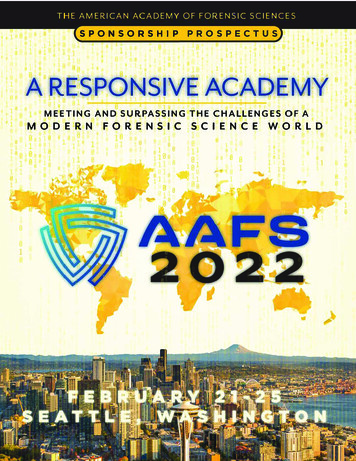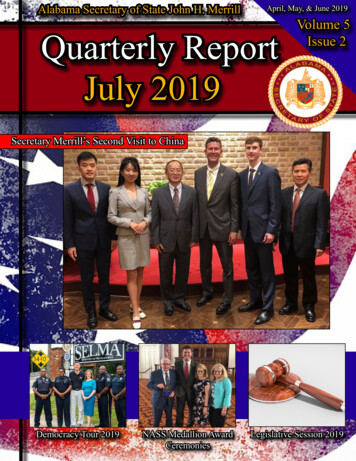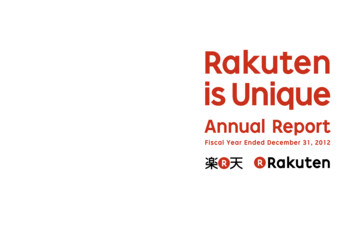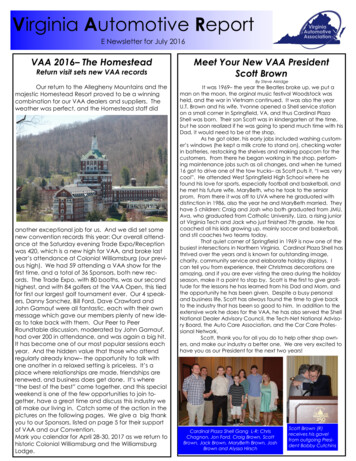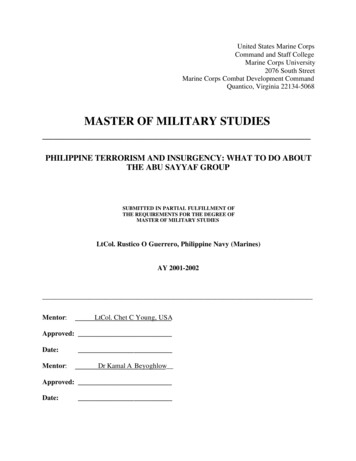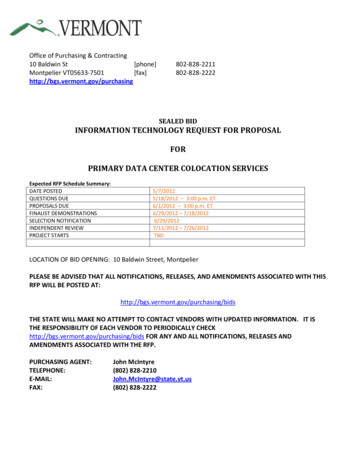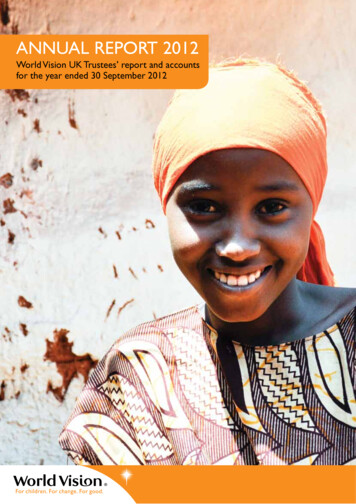
Transcription
ANNUAL REPORT 2012World Vision UK Trustees’ report and accountsfor the year ended 30 September 2012
OUR VISIONOUR ACTIVITYOur vision for every child, life in all its fullness;Our prayer for every heart, the will to make it so.World Vision is the world’s largest international children’scharity, working to bring real hope to millions of childrenin the world’s hardest places. And we do it all as a sign ofGod’s unconditional love.OUR MISSIONTo inspire the UK to take action that transforms thelives of the world’s poorest children.OUR GOALTo be transforming the lives of eight million childrenaround the world with the help of 500,000 supportersin the UK.OUR VALUESThe core values that guide our behaviour are: Weare Christianare committed to the poor We value people We are stewards We are partners We are responsive WePoverty, conflict and disaster hit children harder thananyone. It is in response to this that we work to create aworld where each child is loved, protected and cared for,and enjoys good health and an education.Our local staff work in thousands of communities acrossthe world. They know the names and stories of each childthey help to support – children like Nadira and Jenneh,whose stories you can read on pages 5 and 11 of thisreport. They live alongside these children, their familiesand communities to help change the world they live in,and to change it for good.We know too that there is hope for these children iftheir voices are recognised and heard by nationalgovernments and key policy-makers. This is why we useour influence and global reach to ensure that children arerepresented at every level of decision-making, fromcommunity meetings to international summits.World Vision UK is part of the World Vision Partnership,which works in close to 100 countries.As a charity, World Vision UK’s activities must be carriedout for the public benefit. This report outlines specificactivities – based on our 2011-15 strategy – which wereundertaken for this purpose during the financial yearended 30 September 2012 under four priorities: Evidenceof real change for childrentransformed supporter experience Growing our income and influence Being an inspiring and effective organisation A
CONTENTSReportFrom the Chair and Chief ExecutiveMy community, World Vision, and me.Five-year financialsOur finances at a glanceFor children. For change. For goodPriority one2467810Evidence of real change for childrenPriority twoA transformed supporter experiencePriority three1822Growing our income and influencePriority fourFinancial statementsStatement of financial activitiesBalance sheetStatement of cash flowAnalysis of net fundsNotes to the accountsIndependent Auditor’s ReportBiographies of TrusteesTrustees, Principal Officers and AdvisorsThank youBibliographyGet involved383940414255565859596028Being an inspiring and effective organisationStrategy and plans for the futureFinancial reviewCorporate structure and governance303134This page: Children, many of them sponsored, play games at theirprimary school in India. 2012 Jon Warren/World VisionCover: 11-year-old Zeituna’s family was among those severelyaffected by drought in the horn of Africa in 2011. Her familyreceived emergency food relief from World Vision and later threegoats to mitigate the impact of persistent drought in the area. 2012 Kenneth Kibet/World Vision
FROM THE CHAIR AND CHIEF EXECUTIVEIt is the lives of children that speak best of World Vision’simpact in 2012. It is their voices and faces that togetherwith many impressive facts and figures fill this annualreport. Children like Christopher and Nadira (pages 4-5)who are safe from harm, healthy and full of hope fortheir future.In 2012 we reached 3.8 million children like Jenneh(page 11) in many of the world’s hardest places. Theirlives are being transformed thanks to the actions ofnearly 150,000 committed supporters in the UK.Thankfully, 2012 was a year with fewer majorhumanitarian emergencies than recent years, whichmeant that we supported slightly fewer children than thefour million we helped in 2011. We’ve been able to raisemore income and send more funds to projects overseasthis year, with our total income growing by one percentto 68.8 million. More important is the difference thatthese funds make in the lives of children and families andone of the highlights of 2012 was our Impact Report (seepage 15), full of evidence from communities andtransparent about the ways we can do even better.World Vision works in many countries that put the UK’seconomic difficulties into perspective and anotherhighlight of 2012 was our launch of ‘Raw Hope’, a newway to save and protect children in the most fragile anddangerous places. While there were no earthquakes ortsunamis hitting the headlines in 2012, a chronic foodcrisis was unfolding across West Africa. We took earlyaction by responding not only with food, water andhealthcare but by raising public awareness here in the UK.Our social media #ShareNiger campaign reached overnine million people and with other agencies andgovernments we were able to prevent the food crisisfrom becoming a catastrophe.Justin meets 11-month-old Ramin at a health clinic inAfghanistan. 2012 Chris Weeks/World Vision2World Vision2012 Annual report and accountsWe’ve faced challenges closer to home too – it’s becomeharder than ever to recruit new supporters and in orderto protect our funding to projects overseas, continueinvesting in fundraising and steward wisely the fundsentrusted to us we reduced our staffing here in WorldVision UK. The commitment of our very talented staff hasbeen fantastic throughout.As the year ended, we got an unexpected glimpse ofchange for one child with an update from Zam Zam –the tiny Somali girl who was brought back from the brinkof starvation in 2011 and was the focus of our East Africafamine appeal. Zam Zam is now a healthy toddler andher mum Leila told us her joy at now having her ownhome: “I know the house belongs to me and my family,and it belongs to us forever”.Thank you to all of our supporters and partners forhelping World Vision bring so much change for so manychildren like Zam Zam and Jenneh in 2012. We givethanks to God who is wonderfully at work in, andthrough, all of us striving to bring closer our vision of aworld where every child is protected, educated, healthyand loved. We look forward to our partnership in 2013as we work to protect children, enhance childsponsorship and campaign together to ensure that nochild goes to bed hungry.Justin ByworthChief ExecutiveMark SheardBoard ChairMark meets children being supported by World Visionduring a visit to projects in Myanmar. World Vision
In 2011, Zam Zam, was on the brink of starvation (picturedabove left) and living in a makeshift shelter in Puntland, Somalia. Ayear on from our famine appeal for the region, Zam Zam (aboveright and below) is a happy and healthy toddler. World Vision hasalso provided a permanent home for Zam Zam, her mother Leilaand her five siblings. See page 17 for more details. World VisionWorld VisionAnnual report and accounts 20123
MY COMMUNITY, WORLD VISION AND ME.World Vision is committed to helping the most vulnerable children living in the mostvulnerable places. Here, two young people talk about some of the World Visionprojects that are helping to change their lives. 2012 Collins Kaum 2012 Collins Kaumba/World Visionba/World VisionChristopher in the local primary schoolWE’RE CREATING CHANGEChristopher, 14, lives in Zambia. His community isbenefiting from a number of projects supported byWorld Vision, including a new school, clean drinkingwater and training for local farmer s.The new school, opened by World Vision, is the first inChristopher’s village. “As a result of lacking a school inthe past only a few children could attend,” explainsChristopher, “and most of those have never finished theirprimar y education because the schools they attendedwere far.”Christopherat the new boreholeWorld Vision has been helping local farmer s by equippingthem with seeds and skills to increase their yield, enablingthem to provide more nutritious food for their familiesand crops to sell further afield.“Now that farmer s are able to produce a lot of crops forsale, it is us the children who are benefiting as ourparents are able to send us to school,” explainsChristopher. He adds, “it is always a joy and encouragingto us children to go to school if there is enough food toeat in the home.”mba/World Vision 2012 Collins Kau“Now that we have the school, as children we will growin mind so that when we grow up we can start and runour own businesses and improve our lives.”As well as the school, World Vision has helped provideclean water in the village. “Before the drilling of theborehole in this area many people, including children,used to die of dysentery, diarrhoea and cholera becauseof drinking dirty water. Now that we have clean water itis rare that people suffer,” says Christopher.Christophermeets a farmer who’s recetraining fromivedWorld Vision4World Vision2012 Annual report and accounts
2012 Meg Sattler/World Vision“My father died last year,” she explains. “He wanted me toget an education but now that he is gone, my brother anduncle don’t want me to leave the house. They thinkpeople will talk.”“I’ve been coming [to the centre] for three months, justto learn vocational skills, not formal education. That is thecondition. My brother and uncle won’t let me get aneducation because they think I will go places with boys,or with friends, or I’ll become independent. They don’twant me to be independent.”Family honour, taken very seriously in parts of Pakistan,can result in severe consequences for children whoappear to be jeopardising it. As such, many childrenand young people, particularly females, are kept frompublic life.15-year-old Nadira talks about her dreamsforthe future.WE HAVE HOPE15-year-old Nadira*, from Pakistan, has been preventedfrom accessing an education by her family, and dreams ofa better life. A World Vision drop-in centre is providingrespite and support to Nadira. Staff in the centre offerpsycho-social care, education and life-skills activities,livelihoods training, basic health monitoring and familyoutreach, in an effort to protect children from some ofthe many dangers prevalent in the community.Nadira comes in regularly to share her thoughts, feelingsand frustrations. Previously working as a domesticlabourer, the teenager has now been forbidden to goto work by her family. She has, in fact, been forbidden togo anywhere.“My brother doesn’t allow me to go out because of twoincidents that happened in the street,” Nadira continues.“There was one old man in the street, he took a sevenyear-old girl into his house with a bad intention. Thereare also some young guys in the street who harass girls.When I was allowed to be outside, boys who passedby me in the street used to do the same with me.It happens.”Nadira is well aware of the importance of being safe. Infact it’s something she has been learning more and moreabout at the drop-in centre.“I’ve learned a lot from here,” says Nadira. “Now I canstitch clothes, I have learned how to make things, goodthings, from stitching different materials. But the best thingis, I have learned how I can protect myself; against peoplein the street, or people who want to hurt me. I also knowabout how to protect myself against diseases, withhygiene. I didn’t know before.”Nadira excuses herself. She says goodbye, and smiles.She’s heading home; but she’ll be back here tomorrow.* Nadira’s name has been changed to protect her identity 2012 Muhammad Ali/World Visionorld Vision 2012 Muhammad Ali/We centreys learning at thHumera, 10, enjoEmbroidery is one of thevocationalskills taught at the centreWorld VisionAnnual report and accounts 20125
FIVE-YEAR FINANCIALSCommitted giving and other donations2008 ’0002009 ’0002010 ’0002011 ’0002012 ’00041,71438,97140,27439,61341,881Donations for emergencies4,5802,2595,0414,8673,732Donations, gifts and 0,69119,01921,057Institutional ,789Costs of generating funds11,13910,2459,70710,51710,959Charitable 8151355,83359,16359,92167,34268,664Net (outgoing) / incoming resourcesbefore investment gains1,964(683)1,066583125Investment gains / (losses)(364)6792(15)98Net movement in 1,891General fund5,8045,6497,6165,4016,230Total funds16,78816,17217,33017,89818,121Donated goods and servicesVoluntary incomeInvestment and other incomeTotal incomeGovernance costsTotal expenditureThe funds of the charityRestricted and designated funds5 YearAverageRatiosPercentage of total expenditure:Costs of generating funds17.0%20.0%17.3%16.2%15.6%16.0%Charitable 4%0.7%0.7%0.7%40 days39 days50 days31 days34 daysGovernance costsFree reserves (1)Number of days’ expenditure (2)61Free reserves comprise the general fund.2Number of days’ expenditure excludes donated goodsand services as these do not involve a cash flow.World Vision2012 Annual report and accounts
16%16%OUR FINANCES AT A GLANCEThe charts below show how the funds we raised during 2012 were sourced andspent on projects to benefit children and communities around the world.HOW EACH IS SPENTHOW WE RAISED THE stitCharitable activities 83%Costs of generating funds 16%Governance 1%%%Emeinc ationsOther12%12%PROJECTS WE FUNDED THIS YEAROUR IMPACT ON CHILDRENLast year we reached 3,800,000 children withour life-changing odsdevelopment 3%Protection 5%Environment 2%Agriculture 2%626,779children have benefited from ourchild protection workOther sectors 5%902,445Advocacy 6%EmergencyEmergencyresponse11%11%responseWater &ChildChildsanitation 6% children have benefited from ourhealth programmesprotection6%6%protectionEducation 10%Other3%3%OtherEducation10%10%EducationDisaster mitigation& emergencyresponse 12%Emresp741,906children have benefited from ourFood Security15%humanitarianworkHealth 34%World VisionAnnual report and accounts 20127
FOR CHILDREN. FOR CHANGE. FOR GOODTransforming the lives of children lies at the heart of World Vision. Not only becauseit is children who suffer most from poverty, conflict and disaster, but because byworking with children we know we can bring about lasting change. In bringing realhope to millions of children growing up in the world’s hardest places, we can helpthem shape a better future for themselves for good.World Vision works with communities, partners and governments in close to100 countries across the world. Our work is focused on three key areas:ENABLING LONG-TERM CHANGEWe know we can’t change the world overnight: lastingchange requires sustained commitment. That’s why wefocus on long-term projects called Area DevelopmentProgrammes (ADPs), where we work alongside severalcommunities in one area for 12-15 years. Projects includemaking sure children are protected, healthy and getting aneducation, helping families to earn a better livelihood, andenabling communities to withstand and bounce back fromconflict and natural disasters. By the time we move on,communities are equipped to develop their own wayout of poverty.GIVING CHILDREN A VOICEChildren have a right to be heard and to have a say in theissues and decisions that affect them and their communities.We speak up for children and give them a voice – we callthis advocacy. By using our influence and global reach, wemake sure that children are represented at every level ofdecision-making, from community meetings to internationalsummits. And by educating children about their rights, wehelp them to speak up for themselves.RESPONDING TO EMERGENCIESConflict and natural disasters affect more than 250 millionpeople around the world, hitting children the hardest.1 With40,000 staff based in nearly 100 countries, World Vision isquick to step in when disaster strikes. Within hours, we areon the ground providing essentials like food, water andshelter, and creating safe zones for vulnerable children.And we stay to help communities recover long after theeyes of the world have moved on.8World Vision2012 Annual report and accounts
VisionPeter, from Kenya, is a memberof the children’s parliamentwhere he shares his views onthe issues that affect him andother local children. 2012 Crislyn Felisilda/World Vision 2012 Lucy Murunga/WorldSSPEAKING OUTIMMEDIATE ACTIONWorld Vision staff in the Philippineswere quick to respond whenTyphoon Washi caused severeflooding. Evelyn and her familywere among those provided withaccess to clean water.ld Vision 2011 Gina Castellanos/WorCHANGING LIVESIn his ADP in Honduras,Oliver now drinks clean waterand goes to school. Cropproduction has improved andprovides his community withnutritious food.World Vision PartnershipWorld Vision works in a federal partnershipin almost 100 countries across the world.World Vision UK ProgrammesIn 2012, World Vision UK funded developmentand emergency programmes and projects in34 of the countries where World Vision works.World VisionAnnual report and accounts 20129
PRIORITY ONE:EVIDENCE OF REAL CHANGE FOR CHILDRENChildren living in the poorest and most fragile countries enjoy good health, areprotected and resilient to disasters.THE CHALLENGEWHAT WE AIM TO DO BY 2015Despite the huge progress World Vision and othershave helped bring over the last few decades - includingimproved access to education and reductions in childmortality – many people in the world are being leftbehind. In particular, those living in places hit by conflict,natural disasters and political upheaval are often cut offfrom the support and the structures that can help themrise out of poverty.When we launched our strategy in 2011, we aimed tobe transforming the lives of eight million children by2015. It’s now clear that, because of the economic crisis,this will take a few years longer than we expected.Without action, children across the world will continueto go to bed hungry, continue to work instead of goingto school and continue to endure poor health – amongcountless other difficulties.We will continue to work in the world’s poorest, mostfragile places, concentrating on child protection, childhealth and humanitarian action – enabling millions ofchildren to grow up healthy, hopeful and free from fear.This year, we decided to make protecting children ourlead theme, so we’ll increasingly address issues such aschild marriage, child labour and supporting childrenaffected by war and conflict.Underpinning this, we’ll continue to make sure whatwe’re doing works. That means strengthening the waywe set targets, measure progress and report on ouroutcomes. As well as ensuring we use our resources aswisely and effectively as possible, having solid evidence ofour impact will help us to inspire and influence others.WHAT WE’VE ACHIEVED THIS YEARWE’VE HELPED TO PROTECT626,779 CHILDRENprotect themselves from abuse. This year, we’ve directlyand indirectly trained 13,906 children in seven countriesin life skills and children’s rights.Violence, abuse and exploitation ruin the lives of millionsof children each year. Around 215 million children areforced to work, more than half in hazardous jobs.2 Everyday, an estimated 3,500 girls will marry before reachingtheir fifteenth birthday.3We’ve also encouraged knowledge of children’s rights inschools. We believe schools should provide a safe,child-friendly environment, and can be a haven forvulnerable children. Education projects form part of manyof our Area Development Programmes (ADPs). Forexample, in Shkodra, Albania, two-thirds of children feeltheir school now provides a safer, more protectiveenvironment.We want every child to live a life free from exploitation,abuse and neglect. That’s why we’ve made protectingchildren our number one priority. In 2012, we supported21 projects across 14 countries to improve childprotection, benefiting 626,779 children.Children standing up for themselves: When childrenknow their rights, they’re better able to defendthemselves and support each other. Where we’vepromoted children’s clubs and life skills, children are muchmore aware of their rights and are taking action toStrengthening protection systems: We’ve helped to maplocal and national child protection systems in 10countries this year, including some of the places wherechildren face the greatest dangers, such as Afghanistan,Democratic Republic of Congo (DRC), Somalia andSouth Sudan. By working with children and communitiesto identify, assess and prioritise child protection issues,continued on page 1210World Vision2012 Annual report and accounts
2013 Jennalise Kassanis/World VisionJenneh, now 15, with friendsBETROTHED BEFORE BIRTHIn Sierra Leone, Jenneh’s* marriage was arranged beforeshe was born - in return for a dowry and the promisethat she’d be allowed to finish her education. Days beforethe wedding and aged just 14, Jenneh learned hermarriage was imminent. Distraught at the prospect, shestarted making plans to run away. Fortunately for Jenneh,World Vision was informed of the situation and thewedding was stopped.Here Jenneh shares her experience:“The first time I met the man I was 11 and I didn’t likehim at all. He was big and much older than me. Heseemed about 41 years old.“I was frightened to go with him. I told my parents I wasnot interested. They told me they had given their wordto this man and they were not prepared to change theirminds for anything. Once they have given their wordit represents them so they told me I was marryingno matter.“So I was not happy but they tried to force me and tearswere running from my eyes and I was very afraid thatthere was nobody to protect me anymore.“I was very happy that World Vision knew about thecase. World Vision looks after children and are againstthese things. I feel protected now.“On the day of the marriage they came, quoted the lawand showed the relevance of leaving the children,especially the girl child, at school because when youeducate a girl you educate the whole nation.“In the future I want to finish my education first, then Iwill establish a business.“I advise that all those in the same predicament, whenthey are being forced to get into marriages that they arenot willing to do or they are not 18 to go to WorldVision and report because World Vision will interveneand that marriage will definitely not happen.”* Jenneh’s name has been changed to reflect her wishesWorld VisionAnnual report and accounts 201211
Today, seven-year old Bakari, from Tanzania, enjoys three meals a day every day and has stopped getting sick. His fatherused to struggle to provide for him and his siblings, but with training and support from World Vision, Bakari’s fathernow grows enough food to feed his family and earn an income. 2012 Adda Amos Ngoya/World Visiontheir root causes and the support available, we get adetailed picture of the threats children face and candevelop effective ways of dealing with them. Nine of the10 countries have used the assessments to designcomprehensive, community-led strategies forstrengthening the child protection system, and six havealready started putting them into practice. After mappingin 10 communities highlighted the lack of any policy orlegislation governing child rights and child protection,we’re helping to develop the first ever child protectionlaw in Somaliland.When children’s rights are violated, they deserve justice– and the process of seeking justice should not causefurther trauma. This year we worked with 174communities in Cambodia, India, Sierra Leone and SouthSudan to improve the way local justice systems handlechild protection cases. This has included training for villagechiefs presiding over child abuse cases and for lawenforcement officers in conducting child-friendlyinvestigations.Challenging harmful traditions: Blood feuds in Albania,female genital mutilation in Sierra Leone: customs thatharm children have no place in the 21st century. This yearwe launched new strategies in 63 communities in threecountries to challenge and reduce traditional practicesthat cause harm, and we’re also building this into many ofour ADPs. We know our approach works: we’ve trained12World Vision2012 Annual report and accountstribal leaders who perform potentially harmful initiationceremonies in child protection, while girls who’ve beento our children’s clubs have resisted early marriage sothey can stay in school.WE’VE HELPED MAKE 902,445CHILDREN HEALTHIERIn 1990, 12 million children didn’t make it to their fifthbirthday; by 2011, that number had fallen to below sevenmillion.4 We’re proud to have played a part in this. Butnearly seven million children dying each year, largely frompreventable diseases, is still far too many. That’s why thehealth of children is one of our top priorities. This year,we worked across 25 countries, through 81 projects toimprove the health of 902,445 children.Nutrition: Good nutrition is the basis of good health. Thisyear, we ran nutrition projects in 37 of our ADPs in 14countries, benefiting 372,171 people. Our work rangesfrom supplying nutrient supplements and treatingundernourished children, to training community healthvolunteers to support breastfeeding mothers and teachpeople about avoiding digestive infections through goodhygiene. This work is having results. For instance in ourKayezi ADP in Malawi, the prevalence of undernourishedchildren has reduced from 10 percent to six percent,while in Bolivar ADP in Bolivia it’s reduced from 45percent to 35 percent.
As well as improving long-term nutrition, we supportchildren in emergency situations. In 2012, we ranemergency nutrition programmes in Somalia, SouthSudan and Ethiopia in partnership with ministries ofhealth, UNICEF, the World Food Programme and localWorld Vision offices. Our focus is on supportingcommunities to address acute malnutrition in childrenthrough partnerships with the local health services. InSomalia, for example, we trained 101 community healthworkers to detect acute malnutrition: they screened25,957 children, referring those who needed help to theright treatment programmes. Similarly, in South Sudan,after community volunteers screened more than 11,000children under five, 2,259 children were treated forlife-threatening severe acute malnutrition and 4,924 formoderate acute malnutrition.Mothers and newborn children: A healthy pregnancy, asafe birth and early vaccinations all make a massivedifference to a child’s chances in life. This year we ran ourMother and Newborn Child Health programme in 23ADPs, reaching 165,289 people across 13 countries. Bytraining and facilitating child health workers and supportgroups within communities we’ve made sure morewomen and children benefit from health services: morewomen receive antenatal and postnatal care; more birthstake place with a skilled birth attendant present; andmore children are immunised against diseases likemeasles and polio.Response: Prompt, decisive action by World Vision andothers stopped the food crisis in the Sahel region ofWest Africa from becoming a catastrophe.By March, there were reports that 18.7 million people inWest Africa weren’t getting enough food, with aroundfour million children at risk of acute malnutrition.5 Wehave a long-term presence in the region, and werealready running nutrition programmes in countries suchas Niger and Senegal. So we’d seen the early warningsigns – erratic rainfall bringing poor harvests and grazing,steeply rising prices putting staple foods out of reach formany – and were ready to respond quickly. We launcheda public appeal that, with UK Aid Match funding from theDepartment for International Development (DIFD),raised over 810,000 and we helped persuadegovernments to intervene. Working with governments,other agencies and NGOs, we stepped up programmesto meet people’s urgent needs. We were among the firstorganisations to provide food as well as health andnutrition programmes, water and hygiene facilities toover 163,000 people. When refugees fleeing conflict inMali arrived in Niger, we were on hand to provide water,hygiene kits and child-friendly spaces.Snapshot of the West Africa food crisis as ofApril 20126Food and livelihoods: Poverty is the biggest cause of illhealth. Across 41 ADPs in 22 countries, our support hasenabled 491,357 people to improve their livelihoods andfood supply. In Libo KemKem ADP, Ethiopia, for example,the average annual household income from farming hasincreased by nearly a third over four years of support,and the period when communities are producing lessfood than they need has shrunk by 35 percent.Through innovations such as irrigation schemes andcrop diversification, families are growing a widerrange of nutritious food for themselves, while betteraccess to markets and savings and credit schemeshas strengthened household incomes.MAURITANIA0.7m3.5 millionMALI0.85mSENEGALWE’VE PROVIDED ESSENTIALSUPPORT TO 741,906CHILDREN THROUGH OURHUMANITARIAN ACTIONEvery year, millions of children are hit by emergencies.Although 2012 featured less high-profile emergenciesthan previous years, World Vision has been there tosupport affected children and their families. Our lifesaving humanitarian action revolves around three Rs:response, recovery and resilience.0.6m2.85 millionBURKINAFASONumber of vulnerable peopleper country1Area affected by drought andat risk of food insecurityDisplacement due to conflict in Mali5.5 millionNIGER1.6mCHAD
2012 Geor
World Vision is committed to helping the most vulnerable children living in the most vulnerable places. Here, two young people talk about some of the World Vision . Child sponsorship 38% Legacies 1% Other donations 12% Gift aid 10% Emergencies inc DEC 5% Institutional grants 31% Donated goods and services 3% Charitable activities 83%

